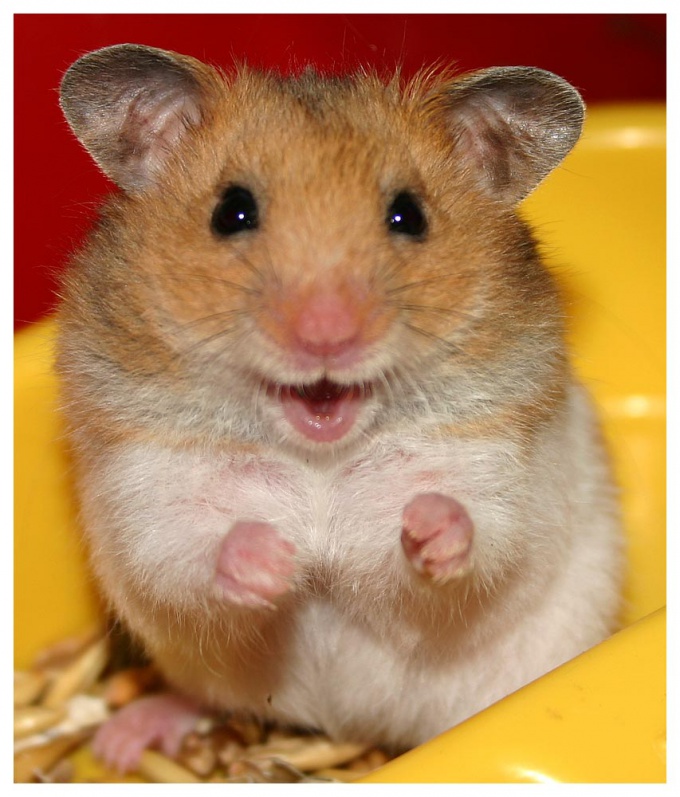Instruction
1
Look closely at the hamster. If the length of the trunk and tail:
- 4-5 cm, and the tail is almost non – existent; the smallest kind of hamster Roborovskogo;
- 7,5-9 cm), tail 1.5-2 cm (Chinese hamster;
- 7,5-10 cm, a tail of 4-10 mm Djungarian hamster, Campbell hamster;
- 13-14 cm), tail 1.5 cm - Syrian or Golden hamster;
- 18-25 cm; tail 7-10 cm - krylovidnymi hamster;
- more than 25 cm and the tail is not less than 3.5 cm hamster ordinary.
- 4-5 cm, and the tail is almost non – existent; the smallest kind of hamster Roborovskogo;
- 7,5-9 cm), tail 1.5-2 cm (Chinese hamster;
- 7,5-10 cm, a tail of 4-10 mm Djungarian hamster, Campbell hamster;
- 13-14 cm), tail 1.5 cm - Syrian or Golden hamster;
- 18-25 cm; tail 7-10 cm - krylovidnymi hamster;
- more than 25 cm and the tail is not less than 3.5 cm hamster ordinary.
2
Determine the color of the hamster:
- light gray or gray with white spots and a dark stripe on the back of a black or dark gray – Djungarian hamster;
Golden yellow or reddish brown with a white belly – Syrian or Golden hamster;
- upper body is red color, lower - predominantly black, the breast and sides of the head three white spots – the common hamster;
- gray-brown, abdomen lighter – krylovidnymi hamster;
- dark brown, abdomen cream-coloured, gray ears, on the back of a dark strip – Chinese hamster;
- legs and belly is white, back is pink-yellow, and the ears are black with a white rim above the eyes are little white spots – hamster Roborovskogo;
- Golden brown with a dark stripe on the back – a hamster Campbell.
- light gray or gray with white spots and a dark stripe on the back of a black or dark gray – Djungarian hamster;
Golden yellow or reddish brown with a white belly – Syrian or Golden hamster;
- upper body is red color, lower - predominantly black, the breast and sides of the head three white spots – the common hamster;
- gray-brown, abdomen lighter – krylovidnymi hamster;
- dark brown, abdomen cream-coloured, gray ears, on the back of a dark strip – Chinese hamster;
- legs and belly is white, back is pink-yellow, and the ears are black with a white rim above the eyes are little white spots – hamster Roborovskogo;
- Golden brown with a dark stripe on the back – a hamster Campbell.
3
Highlight distinctive features, characteristic only for a certain breed of hamsters:
Syrian or Golden hamster has a soft, dense and silky coat and, depending on its length, is of three types: shorthaired, longhaired (Angora) and polyamory;
- krylovidnymi hamster, unlike other breeds, has an elongated torso and long fluffy tail;
- Djungarian hamster differs with pointed muzzle and small ears, the soles of his paws densely covered with hair;
hamster Roborovskogo has kurnosau face and quite big ears, soles of the feet, as well as in the Junggar rocks, strongly pubescent;
hamster Campbell differs round head and short muzzle.
Syrian or Golden hamster has a soft, dense and silky coat and, depending on its length, is of three types: shorthaired, longhaired (Angora) and polyamory;
- krylovidnymi hamster, unlike other breeds, has an elongated torso and long fluffy tail;
- Djungarian hamster differs with pointed muzzle and small ears, the soles of his paws densely covered with hair;
hamster Roborovskogo has kurnosau face and quite big ears, soles of the feet, as well as in the Junggar rocks, strongly pubescent;
hamster Campbell differs round head and short muzzle.
